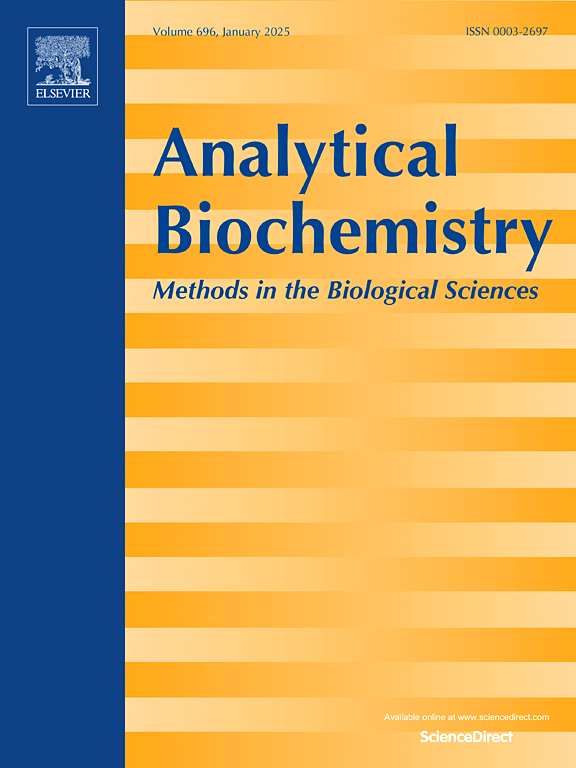基于ncas9的滚圈DNA底物生成方法
IF 2.5
4区 生物学
Q2 BIOCHEMICAL RESEARCH METHODS
引用次数: 0
摘要
滚圈DNA复制是一种DNA复制机制,通过不断复制环状DNA模板来产生长DNA产物。它广泛应用于分子诊断、DNA测序、纳米技术和体外DNA复制研究。滚环复制反应的效率在很大程度上取决于滚环DNA模板的质量。现有的制造滚环DNA底物的方法通常依赖于独特的限制性位点,并且对复制叉的拓扑结构和位置的控制有限。为了解决这些限制,我们提出了一种简单、可定制和有效的策略,用于生产可控制间隙大小和分叉位置的滚圈DNA底物。我们的方法依赖于使用缺口酶Cas9 (nCas9),它可以使用引导rna编程以靶向特定的DNA序列。在一锅反应中,我们将nCas9靶向到18kb质粒上的四个位点,以产生8-11-bp的片段。这些片段被移除,皮瓣寡核苷酸被结扎,以精确控制皮瓣长度和间隙大小构建一个叉。我们展示了这种DNA底物在体外单分子滚圈DNA复制试验中的应用。使用我们的方法,任何质粒DNA都可以转化为滚动圆模板,从而允许生成更多生理相关的DNA模板。本文章由计算机程序翻译,如有差异,请以英文原文为准。

nCas9-based method for rolling-circle DNA substrate generation
Rolling-circle DNA replication is a DNA-duplication mechanism whereby circular DNA templates are continuously copied to produce long DNA products. It is widely used in molecular diagnostics, DNA sequencing, nanotechnology, and in vitro DNA replication studies. The efficiency of rolling-circle replication reaction heavily relies on the quality of the rolling-circle DNA template. Existing methods to create rolling-circle DNA substrates often rely on unique restriction sites and have limited control over replication fork topology and position. To address these limitations, we present a straightforward, customizable, and efficient strategy for producing rolling-circle DNA substrates with control over gap size and fork position. Our method relies on the use of nickase Cas9 (nCas9), which can be programmed to target specific DNA sequences using guide RNAs. In a one-pot reaction, we target nCas9 to four sites on an 18-kb plasmid to create 8–11-bp fragments. These fragments are removed and a flap oligo is ligated, to construct a fork with precisely controlled flap length and gap size. We demonstrate the application of this DNA substrate in an in vitro single-molecule rolling-circle DNA-replication assay. With our method, any plasmid DNA can be converted into a rolling-circle template, permitting generation of more physiologically-relevant DNA templates.
求助全文
通过发布文献求助,成功后即可免费获取论文全文。
去求助
来源期刊

Analytical biochemistry
生物-分析化学
CiteScore
5.70
自引率
0.00%
发文量
283
审稿时长
44 days
期刊介绍:
The journal''s title Analytical Biochemistry: Methods in the Biological Sciences declares its broad scope: methods for the basic biological sciences that include biochemistry, molecular genetics, cell biology, proteomics, immunology, bioinformatics and wherever the frontiers of research take the field.
The emphasis is on methods from the strictly analytical to the more preparative that would include novel approaches to protein purification as well as improvements in cell and organ culture. The actual techniques are equally inclusive ranging from aptamers to zymology.
The journal has been particularly active in:
-Analytical techniques for biological molecules-
Aptamer selection and utilization-
Biosensors-
Chromatography-
Cloning, sequencing and mutagenesis-
Electrochemical methods-
Electrophoresis-
Enzyme characterization methods-
Immunological approaches-
Mass spectrometry of proteins and nucleic acids-
Metabolomics-
Nano level techniques-
Optical spectroscopy in all its forms.
The journal is reluctant to include most drug and strictly clinical studies as there are more suitable publication platforms for these types of papers.
 求助内容:
求助内容: 应助结果提醒方式:
应助结果提醒方式:


